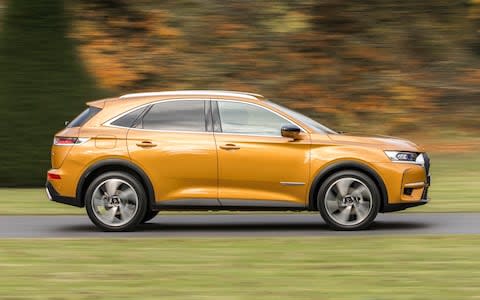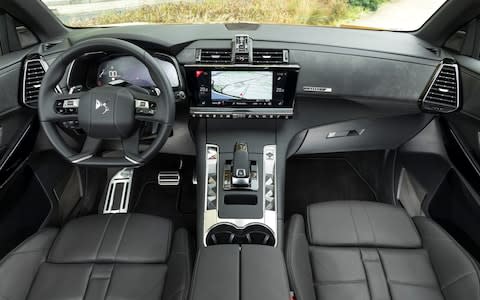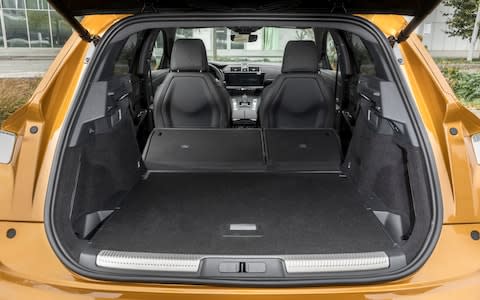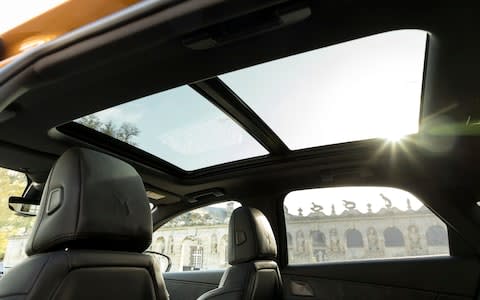DS 7 first drive: can it do a Macron and take centre stage from the Germans?

There was lively discussion of typical buyers for the DS 7, a new mid-sized sports utility with a heavy marketing and design emphasis on French luxury. The three-year-old PSA Peugeot Citroën brand employed Sophie Marceau for its launch in China, but it’s hard to believe she peregrinates on anything other than an ethereal swan’s-down coach, pulled by gilded seahorses wearing jetpacks.
In the end we plumped for a Parisian architect who wears black polo jumpers and shops for cheese on Saturday mornings then sits in Rive Gauche bars arguing about Sartre and the fortunes of the Racing 92 rugby team.
There aren’t many of them, you might say, and that might just be DS’s trouble as it attempts to exit out of the back of the wardrobe into a sort of car-maker’s Narnia, long dreamt of by non-premium marques.
It is called upper non-premium, where mass-market manufacturers leverage their economies of scale and spare production capacity and repackage their cars under swish-looking bodies to sell against the Germans. It has had limited success in the past. Honda, Saab, Ford’s Vignale marque, Nissan’s Infiniti in Europe; none of them has pulled up many trees looking for the upper non-premium market. Let’s see how PSA Peugeot Citroën does with DS.
Actually it has already done pretty well with the DS 3, a cheeky supermini launched in 2010 which occupies 60 per cent of the marque’s total sales (80 per cent in the UK). With the rest of the range - the 4 Crossback, 5 and the Chinese-only 6 - sales haven’t been quite so stellar; read downright awful in the UK.

Not to be outdone, it’s having another go with this DS 7, which goes on sale next year.
For those expecting something as space-age as Flaminio Bertoni and André Lefèbvre’s 1955 Citroën DS, which gives its name to this recent brand, expect on. Based on PSA’s EMP II platform, the five-seat SUV has a layout and mechanical specification that reads exactly like most of its rivals. So that’s an all-steel monocoque with a transverse-mounted engine and gearbox, front-wheel drive (no 4x4 here, for now at least) and MacPherson-strut front and multi-link rear suspension.
A first in this class is the DS’s active suspension system, which scans the road ahead and recognises potholes and bumps and, where appropriate, slackens the damping in bump or rebound to ease the car’s passage. It’s standard on upper specification diesel models and a £1,000 option on the Performance Line trim model.
You’re going to have to judge the looks for yourself. At the achingly cool Paris launch it looked interesting but far from eye-catching and avant garde, which is supposed to be part and parcel of the DS promise.

Start with the basics, and there are five reasonably comfy seats, head and leg room to spare in both front and rear, storage space that’s large and well designed, with connectivity, USB slots front and rear, and even a reclining rear seat and a two-position boot floor on upper spec models.
The choice of materials is high quality and mostly good looking and soft to the touch. But over-the-top design is never far away and the horizontally spinning radio volume control is a masterpiece in how not to do it; even the project’s chief engineer couldn't explain why it was there.
There's a lot of new kit and controlling it isn't always the simplest in the DS7, in part because of the byzantine control logic and also because of that over-designed facia. Adjusting the colour of the displays (“Sensorial Drive” - yuk), is prioritised in the controls as high as, say, adjusting the following distance. We never did quite get the Connected Pilot intelligent cruise-control and lane-keeping assistance (£650 on all except the top model) to fully operate all of time.

There's adaptive LED headlamps with up to five different programs for different driving environments (adverse weather, town, country and so on), and a 360-degree vision, and an infra-red Night Vision system (up to £1,300 on all models). That last system works pretty well, clearly showing pedestrians in the driver's binnacle even when dazzled by on-coming headlamps.
And it's all covered in high-end leathers and a choice of interior trims some of which could out-bling the court of the Sun King, Louis XIV. Where possible, it's of French manufacture; the £990 Focal HiFi stereo, even the BRM clock in the middle of the facia, which denotes not British Racing Motors but Bernard Richards Manufacture, based just outside Paris.
The middling Prestige level on 19-inch alloys, with active-scan suspension, parking sensors and active blind-spot detection is likely to be the most popular UK option, but for our money the Performance Line trim, with much the same equipment but dark-grey Alcantara facia and door panels, is just well, more tasteful.

There are three four-cylinder engines; the 1.6-litre turbo version of the BMW Valvetronic petrol engine (which BMW doesn't use any more), plus 1.5- and 2.0-litre diesels. The high-power units drive through an eight-speed automatic gearbox and there's a six-speed manual to come. In 2019, there will be a plug-in petrol-electric hybrid drivetrain available, with all-wheel drive.
We drove the top-model diesel, which starts quietly but flatters to deceive. It's noisy when pushed and it fires vibration through the throttle pedal. PSA's HDi diesels used to be some of the best in the business and privately DS engineers admit that the higher fuel-injection pressures demanded by Euro 6 emissions requirements are worsening their engines' refinement.
It's a powerful enough, though, with great pulling power and the Aisin eight-speed gearbox is one of the best in the business. On a route which was long on traffic jams and short on fast runs, we achieved about 37mpg.
Only by selecting Comfort mode on the suspension can you access the Active Scan system, which is highly effective at softening the ride over bumps, but is too soft on anything but the worst surfaces and gives a strange weight and feel to the steering.

The Normal setting gave the most natural steering feel and the ride wasn’t at all shabby either, leaving me wondering whether Active Scan is actually all it's cracked up to be.
Dynamically the DS 7 isn’t up to challenging the more overtly sporting cars in the segment, such as BMW’s X1, or Jaguar’s E-Pace, but it’s accomplished at quite brisk speeds while body roll, although noticeable, is well controlled. The 19-inch wheel and tyre option is the one to go for, losing little in handling stakes against the 20-inch rims and having a noticeably quieter ride.
Thus shod it's pretty refined and comfortable at motorway speeds, although there was a fair bit of wind noise over the door tops - early door sealing can be a hit and miss business and this should improve for production.

Bob Lutz, the legendary “car guy” at General Motors, used to say that Saab (once a GM brand) appealed only to intellectual librarians with leather patches on their elbows and there simply weren’t enough of them to justify keeping the marque going. You get the same feeling with the DS 7 and our target Paris architect.
It’s interesting, there’s genuine merit in there, but this car feels like PSA has loaded up a blunderbuss with French design eccentricities and fired it at a perfectly conventional mid-sized SUV.
More discipline, better production values and a more individual appearance will be essential for this new marque. As it is, the DS reach seems slightly beyond its grasp and rivals such as Volvo and Skoda seem to have made a more successful escape from the wardrobe into the Narnia of upper non-premium.
THE FACTS
TESTED 1,997cc, four-cylinder diesel, eight-speed automatic gearbox, front-wheel drive
PRICE/ON SALE range from £28,050 to £43,535 (as tested £45,505)/now, first deliveries late spring
POWER/TORQUE 176bhp @ 3,750rpm/295lb ft @ 2,000rpm
TOP SPEED 134mph
ACCELERATION 0-62mph in 9.9sec
FUEL ECONOMY 57.7mpg/50.5mpg (EU Combined/Urban), on test 37mpg
CO2 EMISSIONS 128g/km
VED £160 first year, then £140
VERDICT A curate’s egg of a car, which offers something genuinely different and luxurious, but is far removed from the avant garde approach that was first promised by DS. Pretty ordinary driveline and, despite the high-tech active scanning of bumps, some rivals have better resolved the issue of SUV ride and handling.
TELEGRAPH RATING Three stars out of five
THE RIVALS
Volkswagen T-Roc, from £20,425
Smaller, surprising and cheaper rival from VW, with jaunty, modern styling, GTI-type performance and good ride/handling. Worth a look if space isn't the final frontier.
BMW X1, from £26,900
Nicely put together and the Efficient Dynamics drivelines are real-world economical. Quite sporting to drive although an update two years ago gave a more compliant ride quality.
Volvo XC40, from £27,905
With a ride and handling compromise that rivals the best in class and a range of strong and economical, if noisy, engines, the XC40 presents a desirable prospect. Good interior, although material choice is patchy and accommodation only adequate, but comfortable.
Skoda Karoq, from £20,660
After the success of the audacious Yeti, the Karoq is a visual disappointment although it's a step forward in interior space, perceived quality and driving dynamics. High-tech damping gives a great combination of ride comfort and handling.
Jaguar E-Pace, from £28,500
Great to look at and sit in, and to drive like a lunatic, but the E-Pace fails to negotiate typical UK roads comfortably. As a sports SUV it more than lives up to its maker's aims, but if you want a mid-sized SUV as a family charabanc there are better compromises around.
For tips and advice, visit our Advice section, or sign up to our newsletter here

 Yahoo News
Yahoo News 
